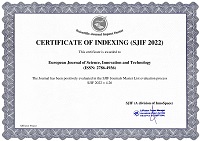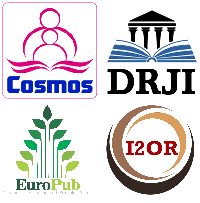Identification of Rice Insect Pests (Oryza sativa) Grown in Kindu: Case of the Lwama I Site
Abstract
The experiment was carried out in the DRC, Maniema Province, City of Kindu precisely in the Lwama I university site. The main objective of this study was to identify the insect pests of rice (Oryza sativa) grown in Kindu. Indeed, in a specific way, we have set the following objectives: to determine the types of insects that attack rice grown in Kindu, and to observe the damage caused by insect pests to the organs of rice grown in Kindu. To achieve these objectives and test our hypotheses, we used the experimental method with a randomized complete block design with 4 treatments and 4 replicates.
At the end of this study, the following results were obtained: (1) The order of orthoptera 29.4% and beetle with 24% were important; (2) 17 species of insect pests have been identified and described; (3) 4 species showed the high number of insects inventoried (Zonocerus variegantus with 38 insects, Orseola oryzivora with 34 insects, Diploxis falaxis with 31 insects and forficula auricularia 28 insects); (4) 3 species caused serious nuisance during the vegetative phase (Coccinella septempunctata with 60%, Cnapholocrosis medinalis and Shistocera gregaria attacked at 55%); (5) 3 species were important for the nuisance in the production phase (Forficula auricularia caused damage at 80% attack, Diaperasticus Erytrocephalus at 70% and Leptoglosus membranaceus at 56.1%).
In view of these results, the production of rainfed rice cultivation in Kindu reinforces a problem related to attacks, especially since each species causes losses on the different organs and on each phase of the plant's development. Losses caused by insects that cut the stubble and destroy the panicles are more formidable.
References
Aurélien, B (2018). Hortisologne gardening advice, planting cultivar, portager and harvesting. www.hortisologne.com
Cohereau, P. (2003). Insects and risk in agriculture. Paris: Arostom-INERA, p. 153.
Dobelman, J.P. (1976). Riziculture practised in irrigation. Paris: French-language internal council, p. 226.
Emongo (2014). Analysis of the effects of biopesticides for maize production at the Lwama I site. University of Kindu FSA unpublished dissertation.
Ekukolé G. & Ajayi O., 2003, some observation on scymnus floralis (F.) and Ischiodon aegyptius (Wiedmann), predators of the cotton aphid in North of Cameroon Journal of African zoology, 109, 93-97.
Gauld I. D. (2015). The hymenoptera. British Museum Natural history. London: Oxford University. Press, 332p.
Guigaz (2002). Method of capture 2. Insectarium of Montreal. 54p.
Heinrichs E.A. (2018). Biology and management of rice insects.
IRRI (2017). Annual report, pp. 25-38. Manila IRRI.
Kasongo K. M. (1997). The enemies of rice in the Sahel. In Integrated pest management of food crop pests in the Sahel (p. 15). INSAF. Seminars and colloquiums. John Libbey.
Laurentiaux (2017). Insect class, assistant at the National School of Mining. Paris, insects Linnaeus 1758, pp. 1-8.
Mignon, J., HauBruget, E., & François, F. (2022). Key to identifying the main insect families in Europe. The Agronomic Presses of Gembloux. Agro-Bio Tech (University of Liège). p. 21.
Ngama (2018). Special Phytopathology Course, University of Kindu UNIKI FSA I Grade Phytotechnics. Unpublished course.
Nwilene F.E. (2019). Current status and management of insect vectors of Rice Yeloz Motle Virus (RYMV) in Africa. Insect Sci. Aplic. Kenya, 19, 179-185.
Ratmadass, G. (2017). Insect pests of legumes and cereals, biology of brown chinal sustainable pest control in Africa, p. 31.
Sadou, et al. (2008). Inventory of insect pests and vectors of yellow variegation of rice in the irrigated perimeters of Maga (Northern Cameroon), p. 41.
Umesh, E., Joshi, R., & Ukwungu, M. (2019). Rice insect pests in the field in Africa: Biology and control method. Research guide. IITA No. 41. Nigeria.
Copyright (c) 2024 Adiyo Sumbu Henriette, Sosthenes Kitaby

This work is licensed under a Creative Commons Attribution 4.0 International License.


 ISSN
ISSN 











